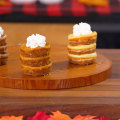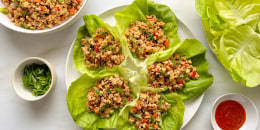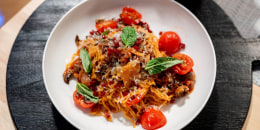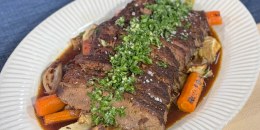Chef notes
Like the cuisine of many cultures, Korean dishes are designed to make use of every scrap of food before it goes bad. Kimchi fried rice is, like bibimbap, a "recipe" that was born of need, when grocery stores weren't around every corner and folks had to make do with whatever they had in the refrigerator. Well, I have never seen a Korean kitchen without kimchi or rice!
Technique tip: Kimchi fried rice is best made when the kimchi is on the older side. Same thing with the rice — this recipe is best with day-old rice.
Swap option: Use the veggie proportions listed here, but just ransack your refrigerator for whatever odds and ends you've got, because just about any veggie is fair game!
Ingredients
- 1/2 red onion, cut into chunks
- 3 scallions, trimmed
- 8-9 cloves garlic, peeled
- 1 cup soy sauce
- 1/4 cup brown rice syrup, or more to taste
- 2 tablespoons rice vinegar
- 2 tablespoons mirin
- 1/2 cup roughly chopped Korean pear or apple
- 1/2 cup roughly chopped red bell pepper
- 1 knob fresh ginger
- 1 teaspoon sesame oil
- 1 teaspoon freshly ground black pepper
- 1/4 cup mushroom dashi or water
- 2 tablespoons potato starch
- 1 cup soy curls
- 1/2 cup Korean Barbecue Sauce (recipe above)
- 1 scallion, cut into 2- to 3-inch lengths
- 1/4 red onion, cut into thin matchsticks
- 1/4 cup chopped green bell pepper
- 3-4 dried shiitake mushrooms
- oil, for grilling
- 1/2 tablespoon sesame oil
- 1 teaspoon toasted sesame seeds
- 1 cup egg replacer, preferably JUST Egg
- 1/2 teaspoon salt
- 1 pinch black salt (optional)
- 1/2 teaspoon freshly ground black pepper
- 1 scallion, chopped
- 2 tablespoons finely diced red bell pepper
- 2 tablespoons finely diced red onion
- 1 tablespoon extra-virgin olive oil
- 4 tablespoons gochujang
- 1 teaspoon yellow mustard
- 1 tablespoon mirin
- 1 tablespoon rice vinegar
- 1 tablespoon maple syrup
- 1 tablespoon soy sauce
- 2 tablespoons vegetable oil, plus more if needed
- 1½ cups day-old cooked rice
- 1 carrot, diced
- 1/2 green bell pepper, diced
- 1/4 red onion, diced
- 1/2 zucchini, diced
- 1 scallion, minced
- 1 cup baechu-kimchi (napa cabbage kimchi), roughly chopped
- 1 teaspoon salt
- 1/2 teaspoon freshly ground black pepper
- 1/2 cup Mushroom Bulgogi (recipe above)
- 1/2 Gyerranmari (recipe above)
- 2 tablespoons Spicy Gochujang Dressing (recipe above) or just gochujang sauce
Preparation
For the Korean Barbecue Sauce:
1.In a high-powered blender, combine the red onion, scallions, garlic, soy sauce, brown rice syrup, rice vinegar, mirin, Korean pear, bell pepper, ginger, sesame oil and pepper, and blend until smooth and frothy.
2.Transfer the mixture to a medium pot and bring to a boil over medium-high heat. Cook the liquid until reduced by about one-third, about 20 minutes.
3.In a small bowl, stir together the mushroom dashi into the potato starch to create a slurry. Gradually stir the slurry into the pot and continue stirring until the sauce thickens.
4.Once the sauce has thickened, remove it from the heat and let it cool (allowing it to thicken a little more). Once cooled, store it in the refrigerator for use in the next several days or freeze it for future use.
For the Mushroom Bulgogi:
1.Soak the soy curls in water for at least 1 hour. Drain and squeeze out any excess liquid. At the same time, soak the shiitake mushrooms to rehydrate, then chop.
2.In a large zip-top plastic bag or reusable silicone bag, place the soy curls, barbecue sauce, scallions, red onion, bell pepper and shiitakes. Make sure all the soy curls are submerged in the sauce. Place it in the refrigerator and marinate for at least 4 hours or up to 24 hours.
3.Preheat a grill or a grill pan (or a cast-iron skillet). Slightly oil the grates or pan. When the grill is hot, place the marinated soy curls, scallions, onions and mushrooms on the grill pan or grill topper, basting with the remaining marinade.
4.Drizzle with the sesame oil and garnish with the sesame seeds before serving.
For the Gyerranmari:
1.In a small bowl (or a measuring cup with a spout), mix the egg replacer, salt, black salt (if using), black pepper, scallion, bell pepper and onion with a fork or small whisk.
2.In a small nonstick skillet, heat 1/2 tablespoon of the oil over medium-high heat. Slowly pour half of the "egg" mixture into the pan — enough to reach the edges of the pan. When the edges start to pull away and the mixture starts to bubble (kind of like a crepe or pancake), use a silicone spatula to begin pulling the edges away all the way around. You can also gently shake the pan to loosen it from the pan.
3.Slowly, using your spatula, lift up the edge of the right side of the egg and begin rolling it toward the left (just like you would roll a sheet of wrapping paper) until almost the entire egg is rolled up. Pull the egg roll back to the right edge of the pan (where you started rolling).
4.Add a little more oil to the pan and pour half of the remaining egg mixture into the empty area of the pan (i.e., the left side of the pan) so that the mixture meets the very end of the rolled egg, creating a seamless sheet of egg. Cook and roll up as above.
5.Repeat steps 2 and 3 until all the egg mixture has been used.
6.Remove the egg roll when it is completely cooked on the outside. It should be roughly 4 to 5 inches long. Slice the roll crosswise into 1/2-inch-thick pieces.
For the Spicy Gochujang Dressing:
In a small bowl, whisk together the gochujang, mustard, mirin, vinegar and maple syrup. Add 1 tablespoon of water and continue to stir. If the sauce is still too thick (it should be the consistency of a salad dressing), add 1 more tablespoon of water and stir. Store in a covered container in the refrigerator for up to 1 month.
For the fried rice:
1.In a large wok or skillet, heat 1 tablespoon of the oil over high heat until it is very hot. Add half of the rice and fry until the rice starts to brown slightly around the edges. Remove the rice from the pan and set it aside. Fry the remaining half of the rice, adding more oil if necessary.
2.Return all the rice to the pan, pushing it to the edges of the pan, creating a small well in the middle. Add 1 tablespoon of oil to the center of pan. Add the diced vegetables, kimchi, salt and pepper to the center of the pan and stir-fry in the well until the kimchi starts to soften, 1 to 2 minutes. Then incorporate the rice and continue to stir-fry everything for 1 more minute.
3.Add the mushroom bulgogi, gyerranmari, and the goghujang dressing. Continue stirring everything over medium heat until the rice takes on a lovely orange color, about 1 minute.













